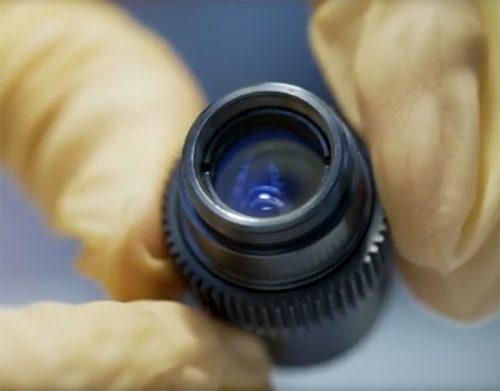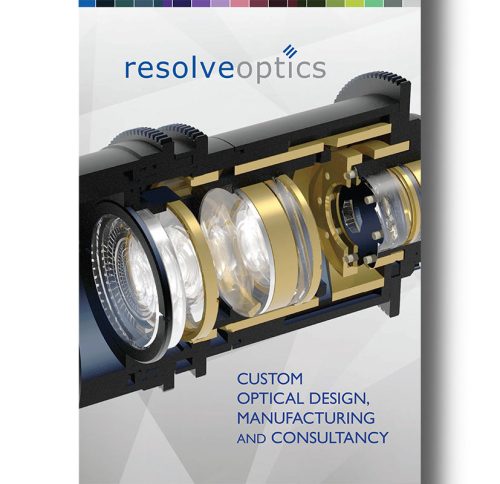
Welcome to the Winter 2022 edition of ‘Lens Innovation’ – a twice yearly eNewsletter from Resolve Optics Ltd. Each issue of Lens Innovation is designed to keep you informed about the latest technological developments, applications advances and breaking news in the optical design and manufacture industry.
If a particular feature interests you do not hesitate to contact us or follow the link for further information. We welcome your feedback.

Mark Pontin – Managing Director
INFORMATION GUIDELINES:
Designing optics for micro and nanosatellites
 The nanosatellite and microsatellite market has seen significant growth in the past few years driven by a desire to reduce satellite costs and the increasing availability of miniaturised technologies. A recent published report has forecast that the global market for nanosatellites and microsatellites is expected to grow from US$2.8 billion in 2022 at an annual rate of nearly 20% over the next 5 years.
The nanosatellite and microsatellite market has seen significant growth in the past few years driven by a desire to reduce satellite costs and the increasing availability of miniaturised technologies. A recent published report has forecast that the global market for nanosatellites and microsatellites is expected to grow from US$2.8 billion in 2022 at an annual rate of nearly 20% over the next 5 years.
A nanosatellite is any satellite weighing between 1kg and 10kg, whereas microsatellites weigh between 10kg and 100kg. These satellites are used for a growing range of applications including remote sensing, earth observation, data communications, scientific analysis, and security / surveillance.
As satellites decrease in size there is the necessity for the optics that lie at the heart of nano and microsatellites to reduce in size and weight. This is not always a straightforward task as quite often the satellite sensor has already been chosen and is 2/3-inch format or larger. A rule of thumb for optical design is the larger the sensor format, the larger the lens. That is unless you are willing to reduce the aperture of the lens. Consequently, if you are developing a camera system for a nanosatellite or microsatellite-based space mission, keep your sensor compact and then it will be possible to keep the lens compact as well.
As the available space for optics in nano- and microsatellites is often a challenge this also has an impact on designing a lens with an appropriate focal length. For instance, if you require your lens to have a focal length of 300mm, then you should expect the lens to be approximately 250mm in length. An alternative optical strategy would be to use a catadioptric or mirror lens. Such lenses are diffraction limited, so offer good resolution, but they typically start at f/3.5 depending on the central obstruction. The overall length of a catadioptric or mirror lens will be shorter, but the diameter will be larger than a conventional lens design.
Being able to keep the size of the lens compact also helps with them withstanding vibration and shock during launch into space as the mass is small. To ensure your nano- or microsatellite optics are sufficiently robust, all elements in our space-ready optics are secured and unable to break loose when subjected to the rigours of launch and other environmental factors.
Currently miniature optical systems for nanosatellites and microsatellites have lower resolution capability compared to dedicated optics installed on large Earth remote sensing systems. However, the considerably lower cost of nanosatellites and microsatellites incorporating compact, low weight optics allows them to form the basis for large-scale orbital constellations made of hundreds of such devices. The development of nano and microsatellite constellations enable Earth monitoring in near real-time mode allowing you to quickly obtain images of your target part of the Earth surface without waiting for a large remote sensing satellite to reach the desired location. This immediate monitoring capability will be valuable in applications including military surveillance in a changing scenario, monitoring spreading disasters (wildfires and flooding) as well as for observation of maturing agricultural crops.
To discuss development of space ready miniature optics optimised for your micro- or nanosatellite application please click here.
VIEWPOINT:
 Key advantages of ‘application-optimised’ custom optical design.
Key advantages of ‘application-optimised’ custom optical design.
Whether you are designing a new product or looking to extend the life of an existing optical product, opting for a custom optical design can minimise any compromises by designing the lens from the ground up to exactly match your needs.
Design parameters that can impact the suitability of a lens for your camera, optical instrument or sensor include:
Size – increasingly optical applications are constrained by a lack of space in which the measurement device can be situated. Keeping lens design compact is a speciality of Resolve Optics.
Format – Sensors are constantly evolving with a notable trend towards non-standard standard formats. Custom lenses are often the only choice if you want an optical system optimised to leverage top performance from a non-standard format sensor.
Resolution – to gain more information from an optical measurement typically requires higher resolution. Achieving highest possible resolution is rarely done with a standard off-the-shelf lens.
Aperture – Lens performance is affected by how much light you can get through it – this is commonly known as the lens F-number. Custom lens design helps you achieve the maximum F-number within the constraints of your application
Wavelength – Most applications have a key bandwidth or wavelength at which optical measurement / sensing is optimally carried out. Rarely do off-the-shelf lenses provide peak performance in the key bandwidth / wavelength for your target application.
Lens housing – Some applications and operating environments place great demands on an optical system. Consequently, having a custom lens housing or mounting arrangement can, for instance, minimise the detrimental effect of vibration or shock.
Security of supply – choosing to incorporate an off-the-shelf lens into your optical product may seem like a good idea but it offers you no security of supply. A key consideration for many companies when choosing a product is security of supply. With a custom lens design from Resolve Optics there is no risk of the lens ever being discontinued, for as long as you keep placing orders, we will continue to manufacture the lens.
While choosing an ‘application optimised’ custom lens design has many advantages, if a suitable off-the-shelf lens is available, we will always make this known to you.
Click here to learn more about application optimised custom optics.
TECHNOLOGY FORUM:
Overcoming the difficulties of using zoom lenses in space
 In previous published articles and interviews (see www.resolveoptics.com/interviews/IEN-Resolve-Optics-Sep-2022.pdf) we have discussed how designing and producing optics for use in space is a highly specialised area where expertise and experience are critical.
In previous published articles and interviews (see www.resolveoptics.com/interviews/IEN-Resolve-Optics-Sep-2022.pdf) we have discussed how designing and producing optics for use in space is a highly specialised area where expertise and experience are critical.
Currently almost all spaceborne optical systems are based on fixed focus lenses and mirrors, why is this when zoom lenses offer many advantages?
One of the biggest advantages of using a zoom lens is that they allow you to change focal lengths without changing your lens. A zoom lens provides a range of variable focal lengths which can be adjusted using the zoom ring on the lens. Because of this inherent versatility – zoom lenses are complex with lots of close tolerance components sliding and rotating within each other. This is fine under normal conditions, but at extremely low and high temperatures or in the vacuum of space producing these movements presents a challenge.
For the components of a zoom lens to move smoothly typically grease must be used. Modern synthetic greases are today much better at not stiffening in cold environments or melting and running when hot. There are also special greases specifically designed for use in the vacuum of space, but these greases tend to be thick and not useable for the fine mechanics you find in zoom lenses.
To address this issue, Resolve Optics has developed an optically corrected zoom lens. This new design concept reduces the moving parts of a zoom lens to just a single push pull movement. This innovation eliminates the need for complex cams and tubes in tubes that are required in traditional zoom lenses. Beneficially our optically corrected zoom lens design also maintains focus and resolution throughout its zoom range.
While our optically corrected zoom lens design has limitations such as the zoom range being limited to approximately 4x, and they do not cope with very wide angles, it shows real promise for use in spaceborne applications.
If you would like to know more, please send us details of your target application by clicking here.
DESIGN FOCUS:
Designing optical systems for use at elevated temperature
 When designing an optical system, you must consider the environmental operating conditions of the application. Typically, optical designs are designed to work at an ambient temperature of around 22° C. Such a design will probably work just fine from 0 to +50° C but any lower or higher and you would probably start to see the image going out of focus.
When designing an optical system, you must consider the environmental operating conditions of the application. Typically, optical designs are designed to work at an ambient temperature of around 22° C. Such a design will probably work just fine from 0 to +50° C but any lower or higher and you would probably start to see the image going out of focus.
It is widely recognised that when materials heat up there is expansion. This rate of expansion differs from material to material. To avoid an optical system going out of focus at elevated temperatures you must carefully consider the rate of expansion of both the components and air spaces.
Higher temperatures will also affect the refractive index of optical materials. To account for optical variations introduced by such physical property changes in materials, systems can be athermalized. The technique of passive athermalization works by choosing lens and housing materials that will compensate for the overall change in optical system performance. The simplest way to do this is to choose materials for the optics and mechanics which have low coefficient of thermal expansion and low thermal coefficient of refraction values. When used correctly – passive athermalization will minimise the effects of temperature change on the system allowing your lens to maintain focus.
Over the last 20 years, we have accumulated the expertise enabling us to design and manufacture specialist optical systems that operate effectively up to 950°C without the need for additional cooling equipment. This has made it possible to undertake applications including optical inspection inside an engine or operating furnace as well as non-invasive monitoring of high temperature processes including incineration, recycling, smelting and chemical manufacturing. To read a case study about a high temperature endoscope development please click here.
CASE STUDY
Fisheye Lens helps improve borehole inspection
 Visual inspection using downhole camera and video are important tools to drillers and borehole maintenance engineers. Such inspection systems are key to determining the condition of a well or borehole as well as the nature and extent of any problems. Using camera or video inspection technology to undertake surveys pre and post treatment are a key component of any maintenance programme as they allow operators to understand the specific areas in a well that may require attention and confirm the effectiveness of the treatment carried out. Inspection surveys also provide a valuable benchmark in the history of the well and its rehabilitation.
Visual inspection using downhole camera and video are important tools to drillers and borehole maintenance engineers. Such inspection systems are key to determining the condition of a well or borehole as well as the nature and extent of any problems. Using camera or video inspection technology to undertake surveys pre and post treatment are a key component of any maintenance programme as they allow operators to understand the specific areas in a well that may require attention and confirm the effectiveness of the treatment carried out. Inspection surveys also provide a valuable benchmark in the history of the well and its rehabilitation.
Recently we delivered the first batch of M12 fisheye lenses to a leading visual analytics company for their new array camera optimised for borehole inspection applications. These specialist lenses were custom designed to extend the capabilities of the array camera, to provide a continuous, 360° view of the internal diameter of a wellbore. The robust lens was optimised to give excellent short distance imaging clarity, a large (186⁰) field-of-view and optical correction for the curvature of the pipe. The clients’ camera features an array of four pre-aligned, high-definition video devices, that together with four application optimised fisheye imaging lenses, uniquely enable the creation of a vivid, 360° dynamic map of well condition and behaviour from the lubricator to the toe of the well in a single, continuous run-in hole. The unique design of the array camera captures four high definition, high frame-rate video feeds and combines them to create an infinitely long, continuous image of the well, significantly reducing the time for data acquisition and increasing the mechanical reliability of the system.
To provide you with a feel of some of the OEM design and development project challenges we have undertaken, the solutions we have proposed and the benefits our customers have gained from the produced special lens or optical system – click here to visit our case studies webpage.

HOT OF THE PRESS
This feature is here to inform you about what is new at Resolve Optics.
New Capabilities Brochure
Our new ‘capabilities’ brochure is a ‘must-read’ for organisations that are considering an optimised custom lens or optical system to help solve an application challenge or increase the competitiveness of their camera, sensor, or optical instrument. This open access download brochure tells you all about Resolve Optics, introduces you to our OEM lens design and manufacture capabilities and most importantly – what makes us different as a supply partner.
Click here to download the brochure now.
 Video introduction to radiation tolerant lenses
Video introduction to radiation tolerant lenses
In nuclear monitoring, spaceborne and certain medical applications having access to lenses and optical systems that are radiation tolerant is critical. Drawing upon over 2 decades of experience and accumulated expertise – Resolve Optics is widely recognised today as the technology market leader. To inform you about our capabilities in this area we have created an informative video.
Click here to watch the video.
 New 3D printing facility
New 3D printing facility
Investment in a new 3D printing facility is enabling Resolve Optics to improve the speed and lower the cost of prototyping small optical components and parts. Advantageously, 3D printing also reduces material consumption, while offering almost limitless freedom of design using a continuous process and the ability to print products directly on a range of substrates, resulting in a functioning, ready-to-use component.
THE LAST WORD:
Why do companies invest in social media and what is in it for end users?
In recent years, social media has become the ‘go to’ digital marketing tool for more and more companies. As the number of social network users continues to soar, sourcing and sharing information on technological innovations, application advances and latest news is increasingly impacted by the likes of LinkedIn, Twitter, YouTube, and Instagram.

However, is investing in social media marketing worth it?
From a company perspective, the biggest advantages of social media are that you can quickly increase your business’s visibility, website traffic, and enquiries at a modest cost. Each social media news item you post will be introduced to a network of targeted individuals, interested in what you do, thereby increasing potential customers. The more people who know about your business, the better. Without marketing your business on social media, your inbound traffic is limited to your usual customers. The people familiar with your company are searching for the same keywords you already rank highly for. Every new piece of social media content you post provides a gateway to your website, and another opportunity to acquire a new interested contact. With increased visibility, your company will generate more opportunities for conversion. Every news post, image, video, or comment may lead viewers to your company’s website and increase traffic. Social media is also a great networking and communication platform that affords companies the ability to interact with customers quickly and easily on a one-to-one basis to increase their satisfaction and loyalty.
From an end user perspective, social media has changed the way we communicate today.
The Internet is a vast reservoir of information. Beneficially, social media allows you to source focused content from thought leaders and media organisations in your target space that you care about and that you want to read. Social media is not just about companies connecting with potential customers, it is also a great tool for building relationships with other people. From a professional perspective, social media allows you to grow your online network by connecting with colleagues, mentors, role models and other professionals. Sharing your expertise and sourced informative content by social media will help you to build your personal brand and attract more professional and personal connections. Using social media is though not just about pushing content, it is also engaging with companies and other people’s content. Following companies and other people and interacting with them on social media will work to build relationships. Being an instant communications medium, social media is also a great tool for connecting before, during and after networking events like conferences, exhibitions, or a business meeting.
This article expresses the personal views of Dr Bill Bradbury – an internationally respected marketeer of optical, scientific and technology brands. Dr Bradbury may be contacted by clicking here.
